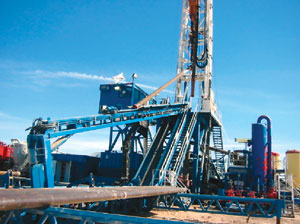New rig designs: Automated casing-while-drilling rig
December 2004 Supplement New Rig Designs Automated casing-while-drilli
Automated casing-while-drilling rigTesco recently updated the rig floor of its automated Genesis series Casing Drilling (trademark) rigs, which were introduced about two years ago. This rig reduces the drilling-crew time spent in the most hazardous work area on a rig. It also improves efficiency by centralizing all controls to the driller, who in most cases is the most experienced person on the rig floor. To enhance the automated pipe-handling process, the company recently added a hydraulic stabbing arm and a breakaway casing-thread protector. The connection process on these Genesis series rigs is as follows: Casing is placed on the hydraulic pipe racks and prepped the same as most other rig operations. The protectors are removed, threads cleaned, each casing joint is numbered and strapped. From here, the process changes from most rig operations. The pipe can now be lubricated and the breakaway thread protectors screwed onto the pin end of casing. The casing joints rest on the hydraulic pipe racks, which are tilted slightly, remotely, by the driller, toward the power catwalk. Casing then automatically feeds to a pipe-indexing system at the end of the pipe rack that allows only one joint at a time to be lifted onto the power catwalk by the waiting hydraulic loading arms. The semi-automatic power catwalk awaits the driller’s command. The driller touches the “continue” button each time he requests it to proceed through the next preprogrammed function. The sequence is: loading arms load the pipe into the trough, the pipe positions itself to the end of the trough, the main frame is then hoisted to the rig floor, where it waits for a command to extend out to the preset point for pickup. The driller then positions the single-joint links with hydraulic single-joint elevators beneath the casing coupling, activates the elevator close command, and he is then ready to hoist the casing joint (see figure).
As the casing joint is hoisted up the mast and the pin end is sliding up the power catwalk trough, the stabbing arm is activated out to grab the pin end of the casing with the stabbing hand as it exits the power catwalk trough. The single joint links and the stabbing arm are floated back to well center. The hoisting equipment is now slacked off, and the breakaway thread protector, with help from the stabbing hand, guides the casing pin safely into the coupling before splitting in two pieces. The driller continues to slack off the single joint elevators and stabs the casing drive head, which is connected to the top drive load path, into the casing and activates the die segments to internally latch the casing joint. The casing drive head never engages the coupling threads and leaves them as new as they were on the casing racks. The top drive now rotates, monitors and records torque, turn and time, while the casing joint is made up to specified torque without having to use a backup tong, since the hydraulic power slips hold back all applied torque. Through this whole process, the last person to touch the casing was the person who applied the lubricant and screwed on the breakaway thread protector when the casing was lying horizontally on the pipe racks. |
|||||||||
- Coiled tubing drilling’s role in the energy transition (March 2024)
- Using data to create new completion efficiencies (February 2024)
- Digital tool kit enhances real-time decision-making to improve drilling efficiency and performance (February 2024)
- E&P outside the U.S. maintains a disciplined pace (February 2024)
- U.S. operators reduce activity as crude prices plunge (February 2024)
- Drilling advances (January 2024)
- Applying ultra-deep LWD resistivity technology successfully in a SAGD operation (May 2019)
- Adoption of wireless intelligent completions advances (May 2019)
- Majors double down as takeaway crunch eases (April 2019)
- What’s new in well logging and formation evaluation (April 2019)
- Qualification of a 20,000-psi subsea BOP: A collaborative approach (February 2019)
- ConocoPhillips’ Greg Leveille sees rapid trajectory of technical advancement continuing (February 2019)




